人教版(2019)必修第三册Unit 1 Festivals and Celebrations 课外拓展中华传统节日腊八节课件(18张ppt)
文档属性
| 名称 | 人教版(2019)必修第三册Unit 1 Festivals and Celebrations 课外拓展中华传统节日腊八节课件(18张ppt) | 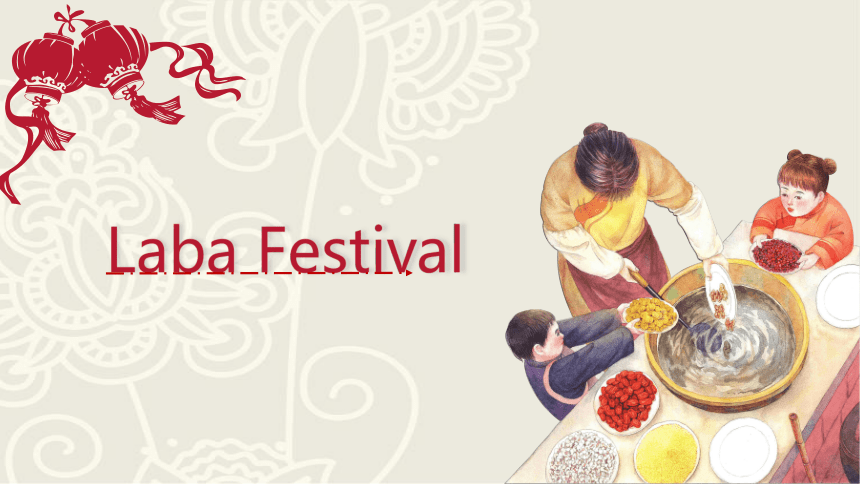 | |
| 格式 | pptx | ||
| 文件大小 | 9.6MB | ||
| 资源类型 | 教案 | ||
| 版本资源 | 人教版(2019) | ||
| 科目 | 英语 | ||
| 更新时间 | 2023-01-16 13:17:43 | ||
图片预览

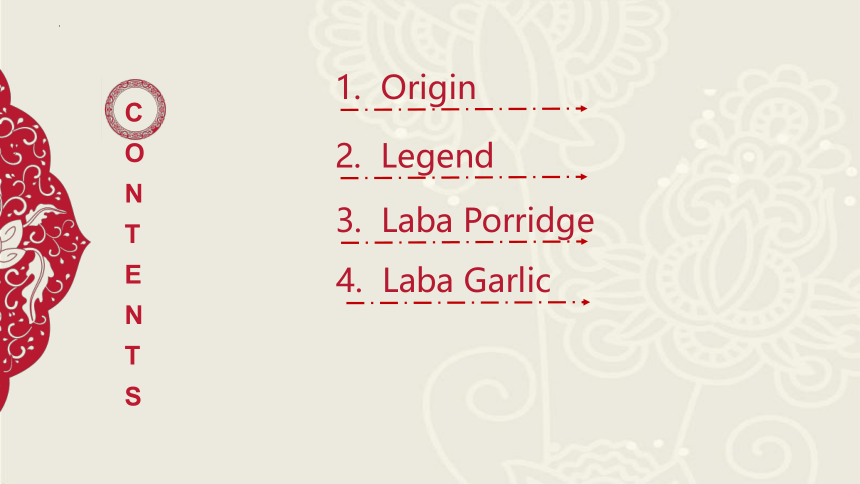
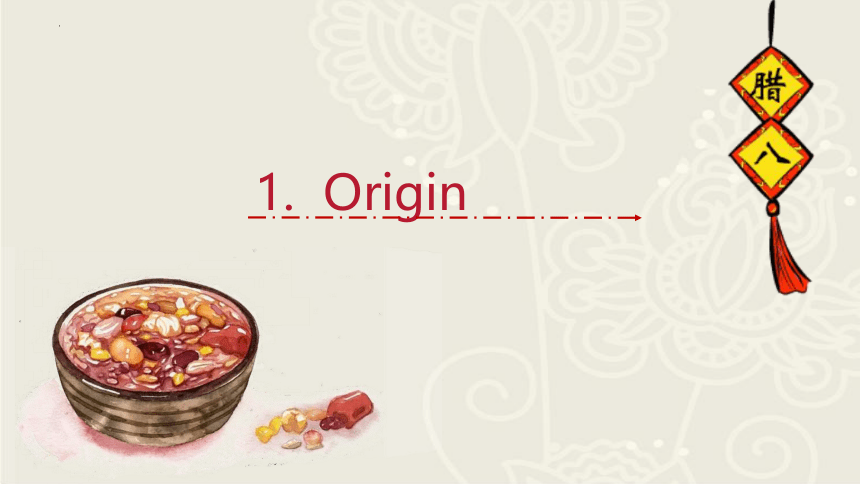
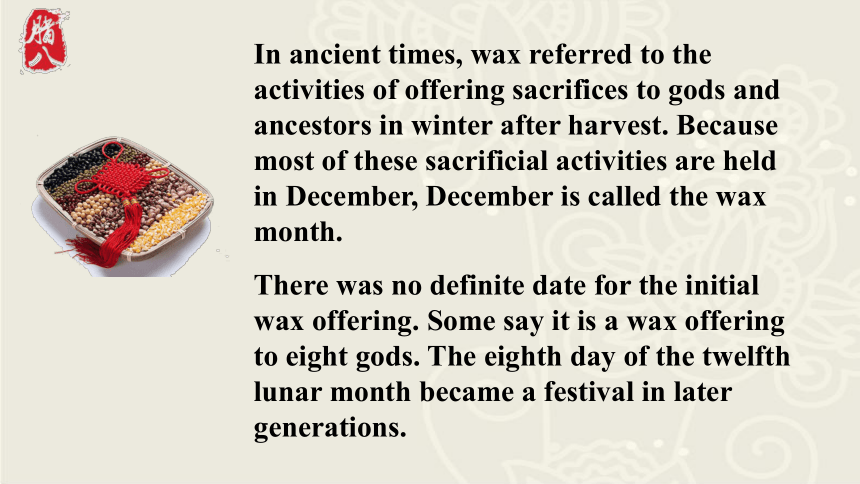
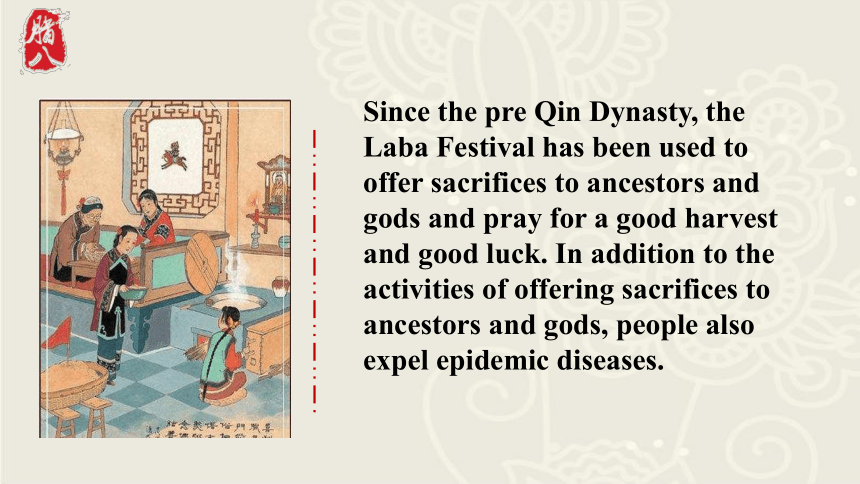
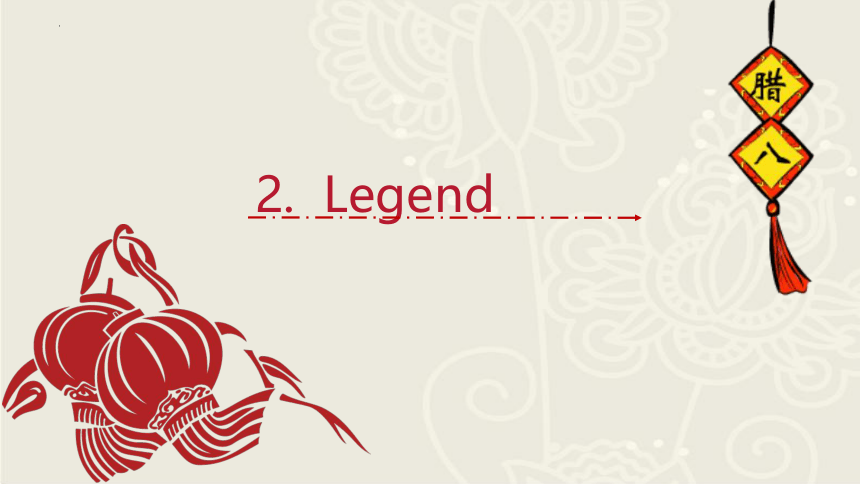
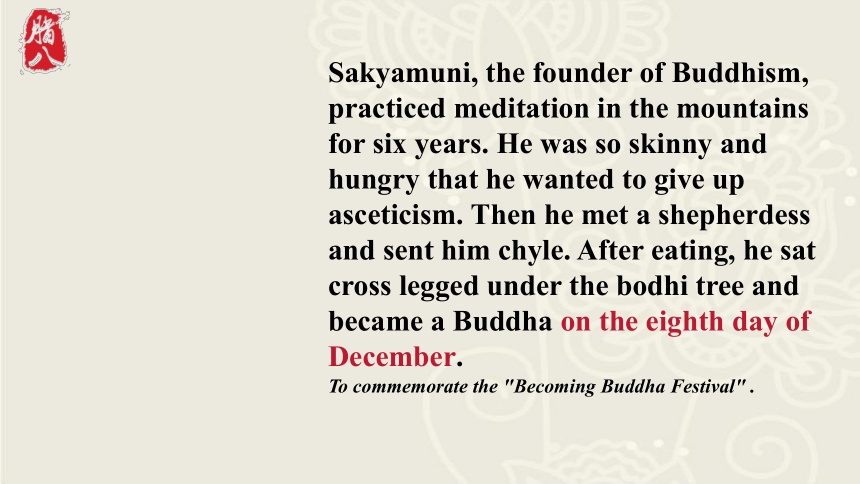
文档简介
(共18张PPT)
Laba Festival
1. Origin
2. Legend
3. Laba Porridge
4. Laba Garlic
C
O
N
T
E
N
T
S
1. Origin
In ancient times, wax referred to the activities of offering sacrifices to gods and ancestors in winter after harvest. Because most of these sacrificial activities are held in December, December is called the wax month.
There was no definite date for the initial wax offering. Some say it is a wax offering to eight gods. The eighth day of the twelfth lunar month became a festival in later generations.
Since the pre Qin Dynasty, the Laba Festival has been used to offer sacrifices to ancestors and gods and pray for a good harvest and good luck. In addition to the activities of offering sacrifices to ancestors and gods, people also expel epidemic diseases.
2. Legend
Sakyamuni, the founder of Buddhism, practiced meditation in the mountains for six years. He was so skinny and hungry that he wanted to give up asceticism. Then he met a shepherdess and sent him chyle. After eating, he sat cross legged under the bodhi tree and became a Buddha on the eighth day of December.
To commemorate the "Becoming Buddha Festival" .
When Qin Shihuang built the Great Wall, migrant workers from all over the world came under orders. They could not go home for many years, and their food was sent by their families. Some migrant workers, whose homes are separated by thousands of mountains and rivers, can not deliver food, resulting in many migrant workers starving to death at the construction site of the Great Wall.
One year, on the eighth day of the twelfth lunar month, the migrant workers without food accumulated several handfuls of miscellaneous grains, boiled them into porridge in a pot, drank a bowl each, and finally starved to death under the Great Wall. In order to mourn the migrant workers who died of starvation at the construction site of the Great Wall, people eat "Laba porridge" on the eighth day of the twelfth lunar month every year.
Laba Festival comes from people's memory of Yue Fei.
Yue Fei led his troops to fight against people of Jin in Zhuxian Town. It was a severe winter. The clothes and food of Yue family's military were poor. The people there sent porridge one after another. The Yue family army had a big meal of "thousand porridge" sent by the people, and returned with great victory. It was the eighth day of December.
3. Laba Porridge
Laba porridge is also called
"Qibao Wuwei porridge"
(seven treasures and five flavors).
China has a history of drinking Laba porridge for more than 1000 years. It first began in the Song Dynasty. On Laba day, Laba porridge is made in the imperial court, government, temples and people's homes.
At the palace, the emperor gave Laba porridge to the ministers. They also distributed rice and fruit to all monasteries for monks to eat. Among the people, every family also wants Laba porridge to offer sacrifices to their ancestors.
Various
kinds
of Laba
Porridge
Many items are mixed in rice, such as red dates, lotus seeds, walnuts, chestnuts, almonds, pine nuts, longans, hazelnuts, grapes, ginkgo, water chestnut, roses, red beans, peanuts...
On the evening of the seventh day of the twelfth lunar month, people began to get busy, washing rice, soaking fruit, peeling, enucleating, and then began to cook at midnight. The porridge would stew over with low fire until the morning of the next day.
4. Laba Garlic
Laba garlic usually refers to the garlic pickled with vinegar. The finished product is green in color, sour and spicy in taste. It is often pickled on the eighth day of the twelfth lunar month, so it is called "Laba garlic". Pickled Laba garlic is a traditional snack mainly popular in northern China.
Laba Festival
1. Origin
2. Legend
3. Laba Porridge
4. Laba Garlic
C
O
N
T
E
N
T
S
1. Origin
In ancient times, wax referred to the activities of offering sacrifices to gods and ancestors in winter after harvest. Because most of these sacrificial activities are held in December, December is called the wax month.
There was no definite date for the initial wax offering. Some say it is a wax offering to eight gods. The eighth day of the twelfth lunar month became a festival in later generations.
Since the pre Qin Dynasty, the Laba Festival has been used to offer sacrifices to ancestors and gods and pray for a good harvest and good luck. In addition to the activities of offering sacrifices to ancestors and gods, people also expel epidemic diseases.
2. Legend
Sakyamuni, the founder of Buddhism, practiced meditation in the mountains for six years. He was so skinny and hungry that he wanted to give up asceticism. Then he met a shepherdess and sent him chyle. After eating, he sat cross legged under the bodhi tree and became a Buddha on the eighth day of December.
To commemorate the "Becoming Buddha Festival" .
When Qin Shihuang built the Great Wall, migrant workers from all over the world came under orders. They could not go home for many years, and their food was sent by their families. Some migrant workers, whose homes are separated by thousands of mountains and rivers, can not deliver food, resulting in many migrant workers starving to death at the construction site of the Great Wall.
One year, on the eighth day of the twelfth lunar month, the migrant workers without food accumulated several handfuls of miscellaneous grains, boiled them into porridge in a pot, drank a bowl each, and finally starved to death under the Great Wall. In order to mourn the migrant workers who died of starvation at the construction site of the Great Wall, people eat "Laba porridge" on the eighth day of the twelfth lunar month every year.
Laba Festival comes from people's memory of Yue Fei.
Yue Fei led his troops to fight against people of Jin in Zhuxian Town. It was a severe winter. The clothes and food of Yue family's military were poor. The people there sent porridge one after another. The Yue family army had a big meal of "thousand porridge" sent by the people, and returned with great victory. It was the eighth day of December.
3. Laba Porridge
Laba porridge is also called
"Qibao Wuwei porridge"
(seven treasures and five flavors).
China has a history of drinking Laba porridge for more than 1000 years. It first began in the Song Dynasty. On Laba day, Laba porridge is made in the imperial court, government, temples and people's homes.
At the palace, the emperor gave Laba porridge to the ministers. They also distributed rice and fruit to all monasteries for monks to eat. Among the people, every family also wants Laba porridge to offer sacrifices to their ancestors.
Various
kinds
of Laba
Porridge
Many items are mixed in rice, such as red dates, lotus seeds, walnuts, chestnuts, almonds, pine nuts, longans, hazelnuts, grapes, ginkgo, water chestnut, roses, red beans, peanuts...
On the evening of the seventh day of the twelfth lunar month, people began to get busy, washing rice, soaking fruit, peeling, enucleating, and then began to cook at midnight. The porridge would stew over with low fire until the morning of the next day.
4. Laba Garlic
Laba garlic usually refers to the garlic pickled with vinegar. The finished product is green in color, sour and spicy in taste. It is often pickled on the eighth day of the twelfth lunar month, so it is called "Laba garlic". Pickled Laba garlic is a traditional snack mainly popular in northern China.
